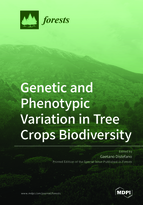Genetic and Phenotypic Variation in Tree Crops Biodiversity
A special issue of Forests (ISSN 1999-4907). This special issue belongs to the section "Forest Ecophysiology and Biology".
Deadline for manuscript submissions: closed (20 September 2020) | Viewed by 53953
Special Issue Editor
Interests: tree crop biotechnology; tree crop genomics; transgenics; biodiversity evaluation and analysis; fruit tree crops breeding; reproductive biology on fruit crops
Special Issues, Collections and Topics in MDPI journals
Special Issue Information
Dear Colleagues,
Genetic and Phenotypic Variation in Tree Crop Biodiversity
The last few years have seen a dramatic increase in the use of DNA-derived data and innovative phenotyping to obtain insights into the causative genes underlying traits of agronomical interest, or to characterize the tree genetic resources. The latter, in particular, could represent an important source of genetic diversity that can be readily used to enhance the adaptability to limiting environmental factors and resistance to biotic stresses, or to promote novel genotypes with improved agronomic traits. Studies may focus on different aspects—such as species relationship and evolution, the extent and distribution of diversity in crop and forestry species, accession identity and detection of novel variants—providing valuable information for germplasm management and the prevention of genetic erosion. In particular, the use of molecular markers could have direct positive implications for the genetic characterization of tree germplasm resources, laying a foundation for the use of genetic polymorphisms to make predictions of phenotype changes through marker–trait association analysis. The paucity of the available phenotypic data, with respect to genetic, is still an important limiting factor, and the linking of genotypic and phenotypic information remains one of the greatest challenges in current genetics research.
On the whole, studies on tree crop biodiversity could provide the essential building blocks to ensure future improvements in production and quality, and for innovations in tree crop development and utilization.
Assoc. Prof. Gaetano Distefano
Guest Editor
Manuscript Submission Information
Manuscripts should be submitted online at www.mdpi.com by registering and logging in to this website. Once you are registered, click here to go to the submission form. Manuscripts can be submitted until the deadline. All submissions that pass pre-check are peer-reviewed. Accepted papers will be published continuously in the journal (as soon as accepted) and will be listed together on the special issue website. Research articles, review articles as well as short communications are invited. For planned papers, a title and short abstract (about 100 words) can be sent to the Editorial Office for announcement on this website.
Submitted manuscripts should not have been published previously, nor be under consideration for publication elsewhere (except conference proceedings papers). All manuscripts are thoroughly refereed through a single-blind peer-review process. A guide for authors and other relevant information for submission of manuscripts is available on the Instructions for Authors page. Forests is an international peer-reviewed open access monthly journal published by MDPI.
Please visit the Instructions for Authors page before submitting a manuscript. The Article Processing Charge (APC) for publication in this open access journal is 2600 CHF (Swiss Francs). Submitted papers should be well formatted and use good English. Authors may use MDPI's English editing service prior to publication or during author revisions.
Keywords
- genetic resources
- molecular markers
- germplasm
- agronomic trait
- conservation






